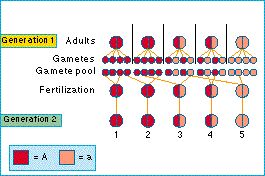Random events in population genetics - How do we calculate the march to homozygosity?

Inbreeding
These two processes by which a gene in a single copy in one individual combines in two copies in an offspring is called inbreeding. As the diagram illustrates, with inbreeding in a finite population, homozygosity is increased over the Hardy-Weinberg level generated by random mating.
The important point is that inbreeding can happen in any breeding system with a small population, and becomes more likely the smaller the population. In an infinite population two copies of the same gene never fertilize each other; but in a small population there is some chance they will.
Figure: a homozygote can be produced either by combining copies of the same gene from different individuals, or by combining two copies of the same physical gene. In a population of six hermaphrodites each produces four gametes. Homozygotes can be produced by the kind of cross-mating assumed in the Hardy-Weinberg theorem (e.g. offspring number 2) or by self-fertilization (offspring number 1).
| Next |



